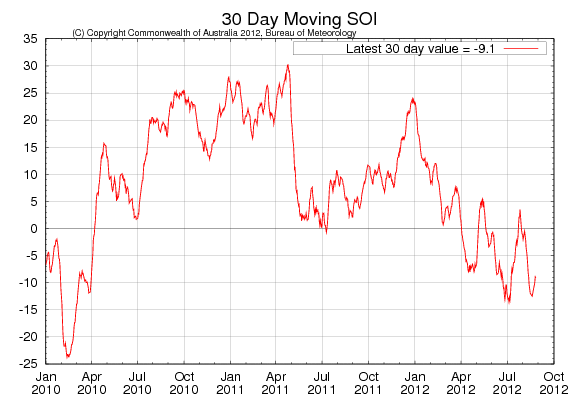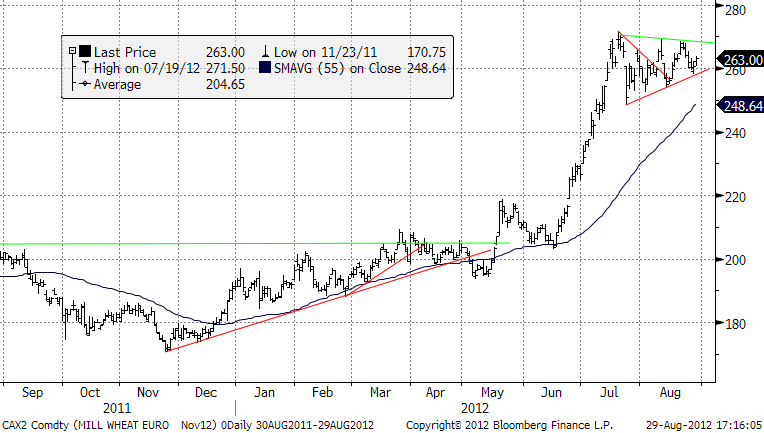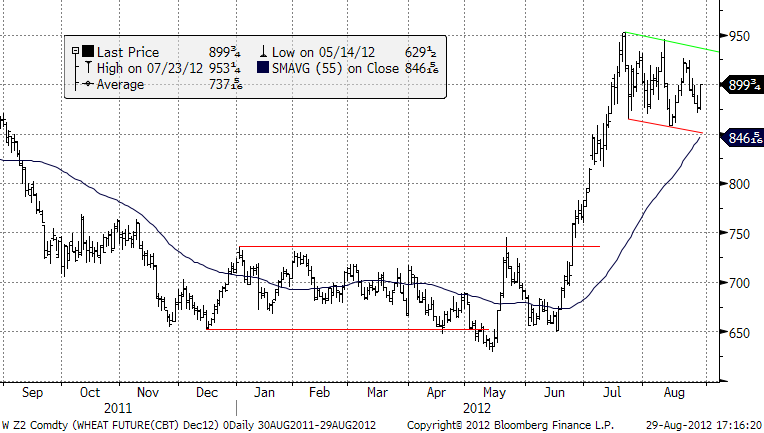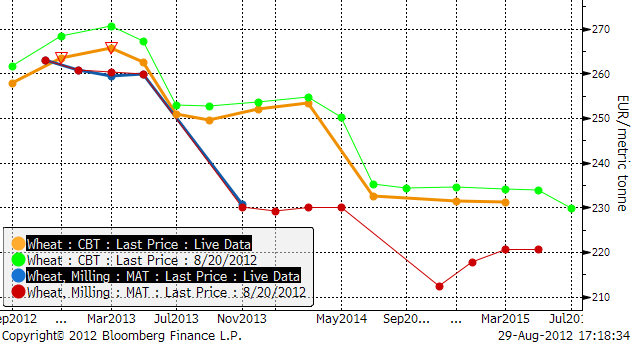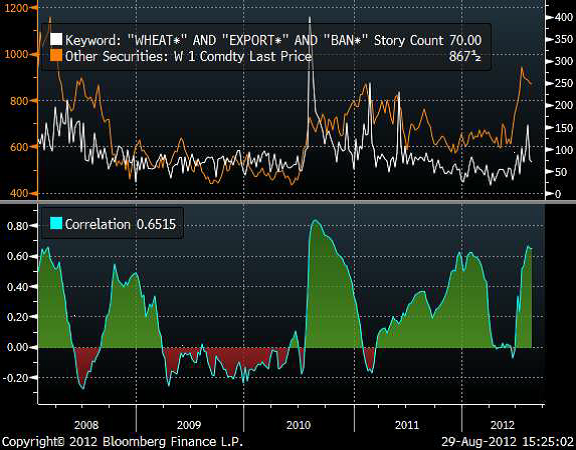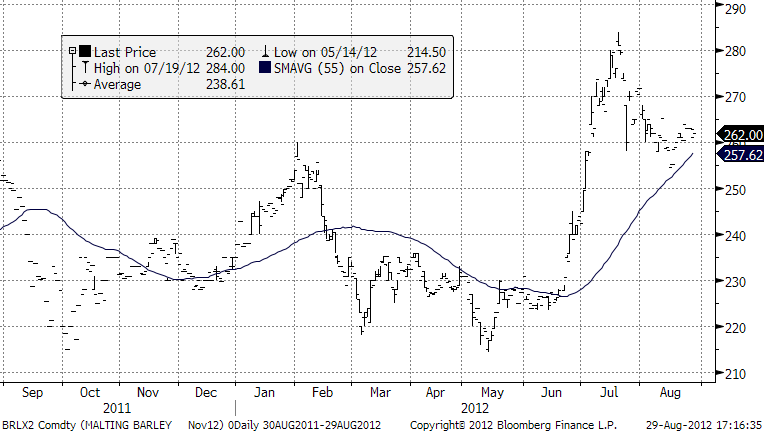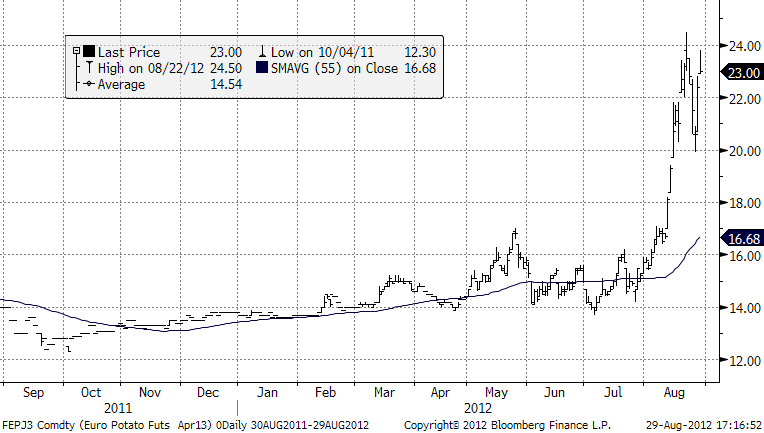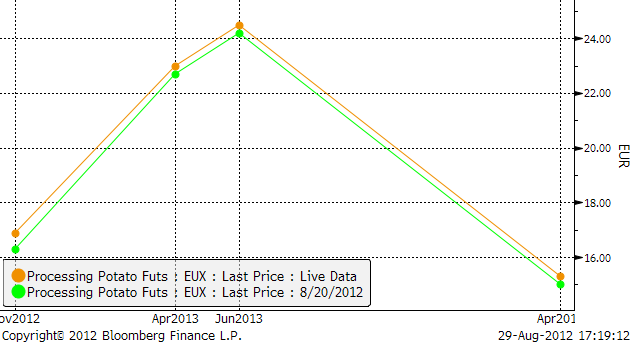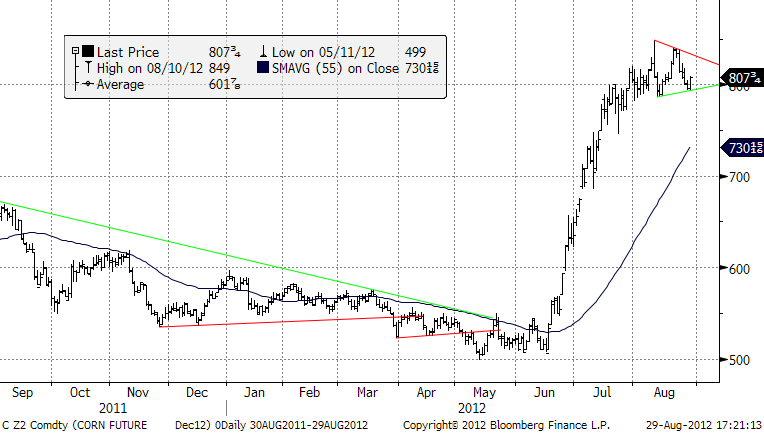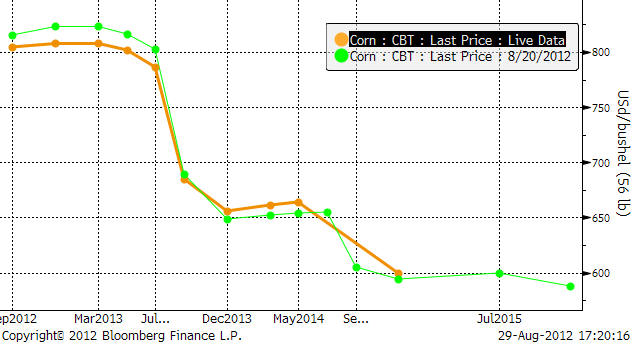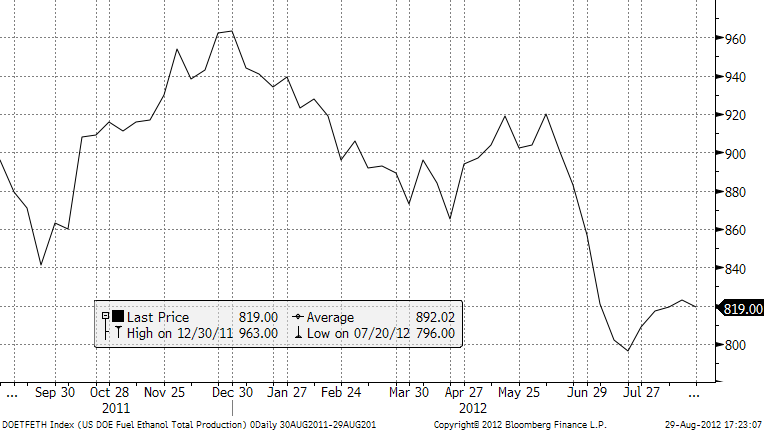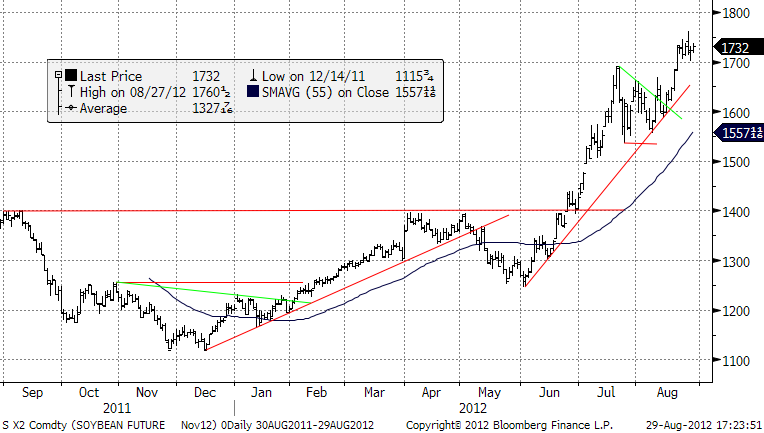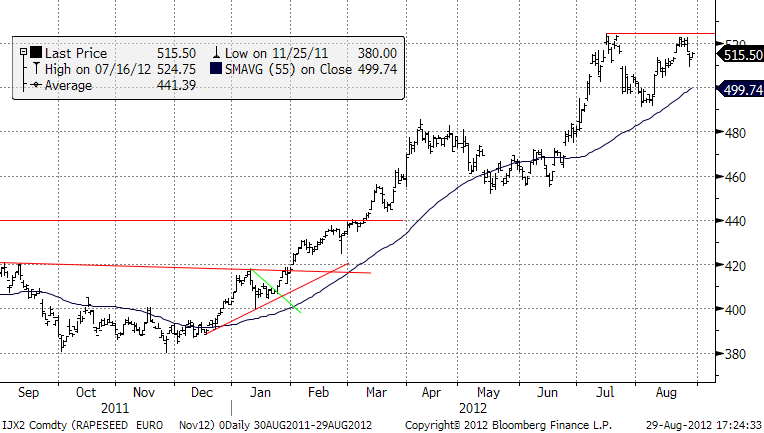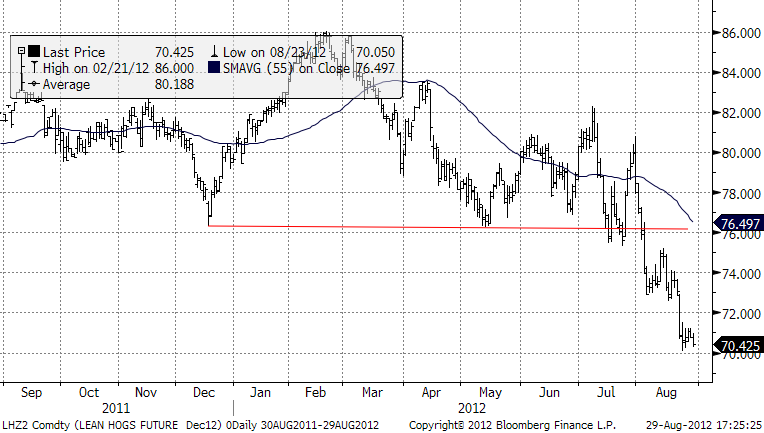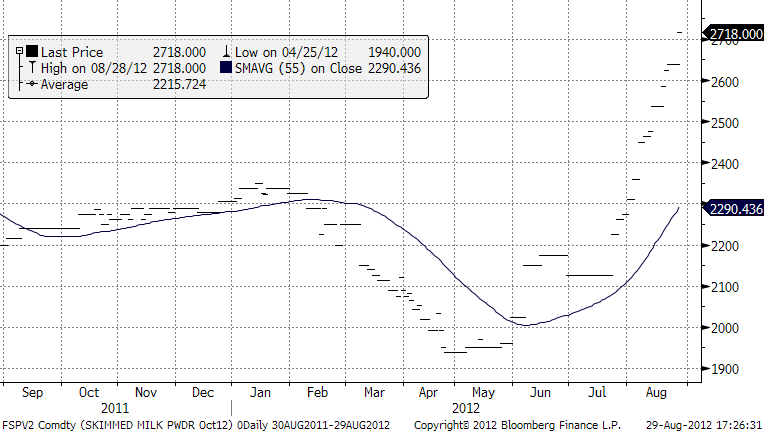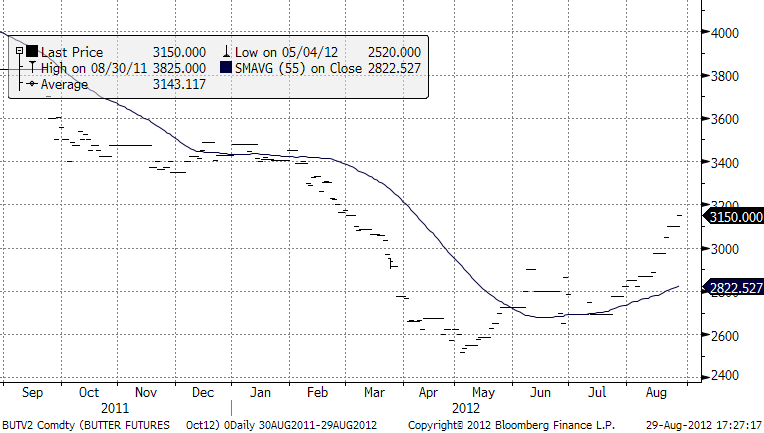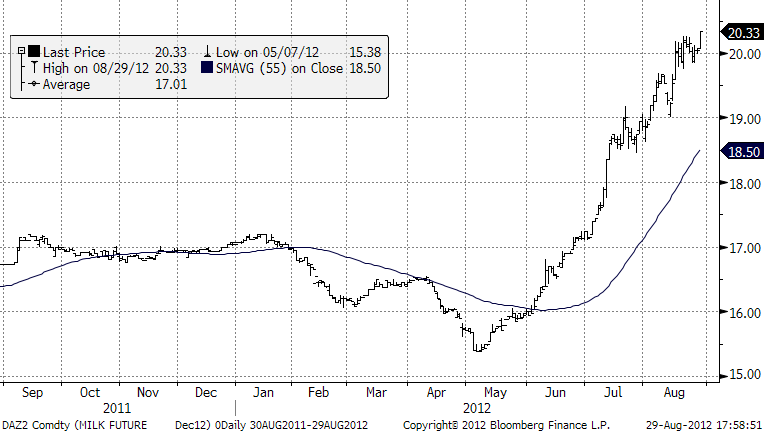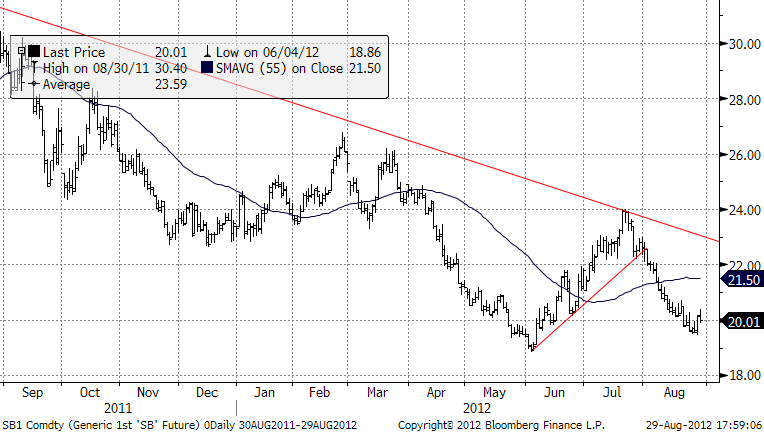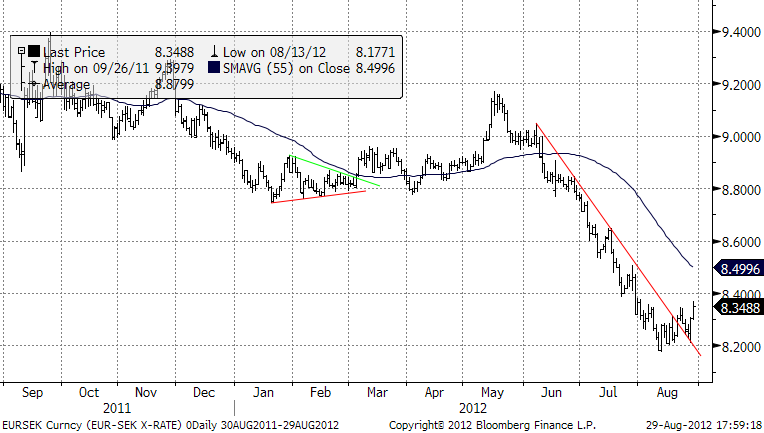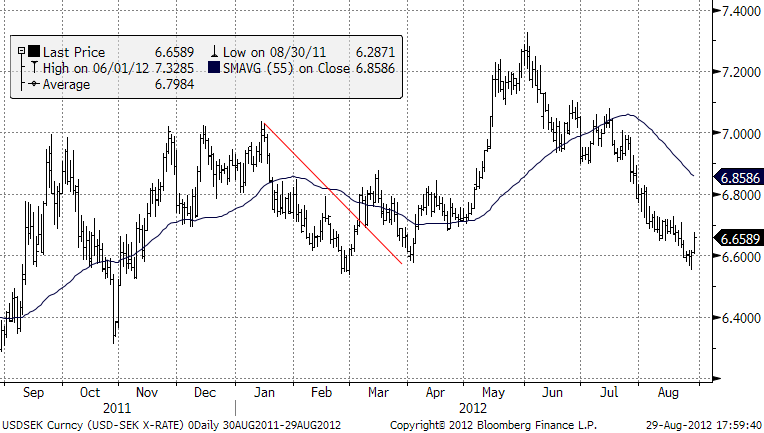Analys
SEB Jordbruksprodukter, 30 augusti 2012
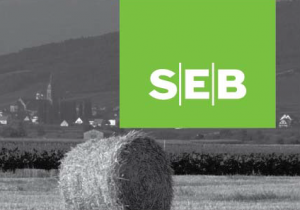 Det har varit stora prisuppgångar på spannmål i sommar. Det finns tecken på att majspriset faktiskt börjar ransonera efterfrågan på majs. Såväl vete som sojabönor ser fortfarande starka ut.
Det har varit stora prisuppgångar på spannmål i sommar. Det finns tecken på att majspriset faktiskt börjar ransonera efterfrågan på majs. Såväl vete som sojabönor ser fortfarande starka ut.
På fredag är det ministermöte (igen) i Ryssland om skörde- och exportsituationen. Nästa vecka kommer WASDE-rapporten. Det finns inte mycket nyheter för marknaden att ta fasta på innan dess, så det lär inte hända så mycket – om nu inte Ryssland ger oss någon nyhet.
Odlingsväder
ENSO fortsätter att surfa på gränsen till ett riktigt El Niño. SOI ligger under gränsen för El Niño på -8. Däremot har andra indikatorer som molnighet inte uppvisat typiska El Niñomönster de senaste två veckorna. Klimatmodeller prognosticerar att ENSO kommer att fortsätta ligga på gränsen fram till slutet av året eller in i början på 2013, för att sedan återgå till normala ENSO-förhållanden.
Vete
Tekniskt har Matif-november fortsatt att röra sig inom den triangel som vi anser kommer att brytas på uppsidan. Ett sådant brott uppåt har enligt den tekniska analysen potential att gå upp till 286 euro per ton. Det finns två potentiella triggers för detta. Det ryska ministermötet på fredag och WASDE-rapporten nästa vecka.
Nedan ser vi Chicagovetet med leverans i december. Den tekniska bilden indikerar samma sak här.
I diagrammet nedan ser vi terminspriserna framåt i tiden för Chicago och Matif och förändringen från 7 dagar sedan. Vi ser att backwardation har minskat i USA. Priset för leverans nästa november (2013) är ca 20 euro per ton högre i Chicago än i Paris.
Det ryska jordbruksministeriet rapporterade igår (onsdag) att 53.4 mt spannmål och baljväxter har skördats hittills. Avkastningen ligger på 1.92 mt / ha. Förra året var det 2.63 ton/ha. Det är en minskning med 27%. Jordbruksministern upprepade sin prognos om en skörd på 75 mt, en minskning med 20% från förra årets 94 mt. Han sade att exportpotentialen är 12 mt. 2011/12 exporterade Ryssland 21.6 mt, enligt USDA.
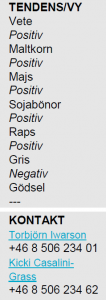 Nu på fredag möts ryska ministrar och experter och diskuterar skörden och exportmöjligheterna. Vi har tidigare visat att Rysslands nya medlemskap i WTO inte har tagit bort risken för ett exportstopp. Enligt WTO:s regelverk får Ryssland införa exportbegränsningar om det meddelar de andra länderna och om exportstoppet är tillfälligt, och det lär det ju vara.
Nu på fredag möts ryska ministrar och experter och diskuterar skörden och exportmöjligheterna. Vi har tidigare visat att Rysslands nya medlemskap i WTO inte har tagit bort risken för ett exportstopp. Enligt WTO:s regelverk får Ryssland införa exportbegränsningar om det meddelar de andra länderna och om exportstoppet är tillfälligt, och det lär det ju vara.
Det är naturligtvis svårt för oss på SEB att följa vad som sägs i hela världen om exportstopp i alla länder. Ett enkelt sätt är att räkna alla artiklar som innehåller nyckelorden Wheat+Export+Ban och det ser vi nedan. Den senaste veckan har det talats mindre om exportstopp. Kanske marknaden är trött på ”storyn”.
Det franska jordbruksministeriet meddelade igår att ”World Food Security Situation Not Threatened for Now”. Fast de sade det väl på franska. Frankrike har inrättat det så kallade ”Rapid Response Forum” förra året för att hindra att länder inför exportbegränsningar. Det är en del av ”The Agricultural Market Information System” som inrättats på beslut av G20. Jag förmodar att de får anledning att träffas igen snart, allra senast efter USDA:s rapport nästa vecka.
De två senaste veckorna har det kommit ner nederbörd över Indien, vilket har fått läget att ljusna för grödor som majs, ris och sojabönor. 50% av Indien är drabbat av torka. Det minskar trycket på staten att införa exportbegränsningar. Arealen sådd med ris har ökat till 32.9 miljoner hektar från 30.8 förra året. Förra årets skörd var rekordhöga 91.5 mt, enligt det indiska jordbruksministeriet.
Orkanen Isaac som nådde fastlandet via Louisiana ger nederbörd, som förbättrar markfukten inför höstsådden av SRWW, även om stormen också fördröjer fältarbetet.
Maltkorn
Novemberkontraktet på maltkorn har funnit stöd och ser ur teknisk synvinkel ut att kunna stiga den närmaste tiden.
Potatis
Potatishaussen fick priset att fortsätta stiga efter förra veckobrevet. Efter att ha nått över 24 euro per deciton, föll priset hastigt tillbaka till 20 euro, men har de senaste två dagarna åter stigit och ligger nu på 23 euro. Vi vet att det fanns säljare på över 24 euro, så det återstår att se om de är starka nog.
Nedan ser vi terminskurvan för industripotatis på Eurex. Priset för nästa års skörd ligger på 15 euro per deciton. Det är det man ska räkna med att få betalt för nästa års skörd.
Tycker man att det är en bra prisnivå kan man välja att sälja terminer för att prissäkra. Korrelationen över skördeåren mellan tysk industripotatistermin och till och med svensk matpotatisnotering är högre än 0.5. Prissäkring med de här terminerna ger en riskminskning. Trots att det är en annan kvalitet och ett annat land.
Majs
Majspriset har inte riktigt lyckats hitta nya toppnivåer och det är ett svaghetstecken. Marknaden ligger inom en triangelformation. Ett brott nedåt ur den vore inte bra och skulle innebära att vi skulle reducera långa positioner kraftigt och kanske till och med gå kort.
Nedan ser vi terminskurvan framåt i tiden för majs.
Måndagens crop ratings för majs var kom in med 22% i good/excellent condition. Förra veckan var det 23%. Poor / Very poor kom in på 52% (upp en procentenhet).
Orkanen Isaac, som nådde fastlandet vid Louisiana kommer att ge mellan 70 och 80 mm nederbörd över Missouri de kommande tre dagarna, enligt National Weather Service. Det kommer också att blåsa en hel del och det kan skada majsfälten som pga torkan har svaga stjälkar. Berörda stater är Louisiana, Alabama, Arkansas och Mississippi. Etanolproduktionen har nu äntligen minskat efter de senaste veckornas uppgång. Det är en minskning från 823,000 fat/dag till 819,000 fat, enligt DOE:s veckostatistik. Vi får tolka det som att det finns tecken på att det höga majspriset faktiskt ransonerar konsumtionen.
Enligt USDA-rapporten den 10 augusti går 42% av amerikansk majsproduktion till etanolproduktion. Priset på etanol har backat i pris de senaste dagarna.
Sojabönor
Triangelformationen är bruten på uppsidan och har nu etablerat sig över toppen från juli. Vi ser det som en konsolidering inför nästa uppgångsfas, till den teoretiska målkursen 1879 cent / bu.
Crop conditions visar en minskning på 1% i kategorin ”good” och en ökning i ”very poor”. 38% är i poor / very poor condition medan 30% är good eller very good condition. Orkanen Isaac ger nederbörd, som berört under majs-avsnittet, men nederbörden är för sen för att påverka sojaskörden, eftersom den är tre veckor tidig och sojabönornas baljor redan är satta.
Raps
Vi tror alltjämt att rapsterminen för novemberleverans är på väg högre. Den snabba ”dippen” häromdagen, som återhämtade sig så snabbt, tyder på att köparna fortfarande har kommandot över marknaden. På ovansidan finns ett motstånd på 524.75 euro per ton. Vi tror att det ska testas igen – och övervinnas.
Gris
Grispriset befinner sig i en tydlig bear market. Nedan ser vi baissen på grismarknaden.
Mjölk
Priset på mjölkpulver i Nordeuropa har fortsatt att stiga ännu en vecka. Nedanför ser vi oktoberkontraktet. Det har fortsatt att öka till 2718, från 2625 euro per ton.
Nedan ser vi priset på smör, också oktoberkontraktet såsom handlat på EUREX. Priset är angivet i euro per ton.
På den amerikanska börsen har priset också stigit. EUREX som representerar marknaden i Europa har börjat bli allt mer med världsmarknadens pris, representerat av terminerna i Chicago.
Socker
Priset på socker har studsat upp från strax under 20 cent och ligger nu på nästan exakt 20 cent. Trenden är ner, men trenden är också gammal.
EURSEK
EURSEK svarar på ett starkt tekniskt stöd. Vi tror på sidledes rörelse den närmaste veckan. Augustis sidledes rörelse såg först ut som en paus inför fortsatt nedgång, men man ska inte se kursrörelser som i tisdags och i onsdags i en korrektion. Vi kan nu få se en uppgång mot 8.50 kr per euro.
USDSEK
Dollarn har svarat på supportområdet och hoppat upp från det. Stödet ligger vid 6.60 kr. Priset kan i första hand gå upp till 6.80, men det mest troliga är fortsatt sidledes rörelse med stödet under.
[box]SEB Veckobrev Jordbruksprodukter är producerat av SEB Merchant Banking och publiceras i samarbete och med tillstånd på Råvarumarknaden.se[/box]
Disclaimer
The information in this document has been compiled by SEB Merchant Banking, a division within Skandinaviska Enskilda Banken AB (publ) (“SEB”).
Opinions contained in this report represent the bank’s present opinion only and are subject to change without notice. All information contained in this report has been compiled in good faith from sources believed to be reliable. However, no representation or warranty, expressed or implied, is made with respect to the completeness or accuracy of its contents and the information is not to be relied upon as authoritative. Anyone considering taking actions based upon the content of this document is urged to base his or her investment decisions upon such investigations as he or she deems necessary. This document is being provided as information only, and no specific actions are being solicited as a result of it; to the extent permitted by law, no liability whatsoever is accepted for any direct or consequential loss arising from use of this document or its contents.
About SEB
SEB is a public company incorporated in Stockholm, Sweden, with limited liability. It is a participant at major Nordic and other European Regulated Markets and Multilateral Trading Facilities (as well as some non-European equivalent markets) for trading in financial instruments, such as markets operated by NASDAQ OMX, NYSE Euronext, London Stock Exchange, Deutsche Börse, Swiss Exchanges, Turquoise and Chi-X. SEB is authorized and regulated by Finansinspektionen in Sweden; it is authorized and subject to limited regulation by the Financial Services Authority for the conduct of designated investment business in the UK, and is subject to the provisions of relevant regulators in all other jurisdictions where SEB conducts operations. SEB Merchant Banking. All rights reserved.
Analys
Tightening fundamentals – bullish inventories from DOE

The latest weekly report from the US DOE showed a substantial drawdown across key petroleum categories, adding more upside potential to the fundamental picture.

Commercial crude inventories (excl. SPR) fell by 5.8 million barrels, bringing total inventories down to 415.1 million barrels. Now sitting 11% below the five-year seasonal norm and placed in the lowest 2015-2022 range (see picture below).
Product inventories also tightened further last week. Gasoline inventories declined by 2.1 million barrels, with reductions seen in both finished gasoline and blending components. Current gasoline levels are about 3% below the five-year average for this time of year.
Among products, the most notable move came in diesel, where inventories dropped by almost 4.1 million barrels, deepening the deficit to around 20% below seasonal norms – continuing to underscore the persistent supply tightness in diesel markets.
The only area of inventory growth was in propane/propylene, which posted a significant 5.1-million-barrel build and now stands 9% above the five-year average.
Total commercial petroleum inventories (crude plus refined products) declined by 4.2 million barrels on the week, reinforcing the overall tightening of US crude and products.


Analys
Bombs to ”ceasefire” in hours – Brent below $70

A classic case of “buy the rumor, sell the news” played out in oil markets, as Brent crude has dropped sharply – down nearly USD 10 per barrel since yesterday evening – following Iran’s retaliatory strike on a U.S. air base in Qatar. The immediate reaction was: “That was it?” The strike followed a carefully calibrated, non-escalatory playbook, avoiding direct threats to energy infrastructure or disruption of shipping through the Strait of Hormuz – thus calming worst-case fears.

After Monday morning’s sharp spike to USD 81.4 per barrel, triggered by the U.S. bombing of Iranian nuclear facilities, oil prices drifted sideways in anticipation of a potential Iranian response. That response came with advance warning and caused limited physical damage. Early this morning, both the U.S. President and Iranian state media announced a ceasefire, effectively placing a lid on the immediate conflict risk – at least for now.
As a result, Brent crude has now fallen by a total of USD 12 from Monday’s peak, currently trading around USD 69 per barrel.
Looking beyond geopolitics, the market will now shift its focus to the upcoming OPEC+ meeting in early July. Saudi Arabia’s decision to increase output earlier this year – despite falling prices – has drawn renewed attention considering recent developments. Some suggest this was a response to U.S. pressure to offset potential Iranian supply losses.
However, consensus is that the move was driven more by internal OPEC+ dynamics. After years of curbing production to support prices, Riyadh had grown frustrated with quota-busting by several members (notably Kazakhstan). With Saudi Arabia cutting up to 2 million barrels per day – roughly 2% of global supply – returns were diminishing, and the risk of losing market share was rising. The production increase is widely seen as an effort to reassert leadership and restore discipline within the group.
That said, the FT recently stated that, the Saudis remain wary of past missteps. In 2018, Riyadh ramped up output at Trump’s request ahead of Iran sanctions, only to see prices collapse when the U.S. granted broad waivers – triggering oversupply. Officials have reportedly made it clear they don’t intend to repeat that mistake.
The recent visit by President Trump to Saudi Arabia, which included agreements on AI, defense, and nuclear cooperation, suggests a broader strategic alignment. This has fueled speculation about a quiet “pump-for-politics” deal behind recent production moves.
Looking ahead, oil prices have now retraced the entire rally sparked by the June 13 Israel–Iran escalation. This retreat provides more political and policy space for both the U.S. and Saudi Arabia. Specifically, it makes it easier for Riyadh to scale back its three recent production hikes of 411,000 barrels each, potentially returning to more moderate increases of 137,000 barrels for August and September.
In short: with no major loss of Iranian supply to the market, OPEC+ – led by Saudi Arabia – no longer needs to compensate for a disruption that hasn’t materialized, especially not to please the U.S. at the cost of its own market strategy. As the Saudis themselves have signaled, they are unlikely to repeat previous mistakes.
Conclusion: With Brent now in the high USD 60s, buying oil looks fundamentally justified. The geopolitical premium has deflated, but tensions between Israel and Iran remain unresolved – and the risk of missteps and renewed escalation still lingers. In fact, even this morning, reports have emerged of renewed missile fire despite the declared “truce.” The path forward may be calmer – but it is far from stable.
Analys
A muted price reaction. Market looks relaxed, but it is still on edge waiting for what Iran will do

Brent crossed the 80-line this morning but quickly fell back assigning limited probability for Iran choosing to close the Strait of Hormuz. Brent traded in a range of USD 70.56 – 79.04/b last week as the market fluctuated between ”Iran wants a deal” and ”US is about to attack Iran”. At the end of the week though, Donald Trump managed to convince markets (and probably also Iran) that he would make a decision within two weeks. I.e. no imminent attack. Previously when when he has talked about ”making a decision within two weeks” he has often ended up doing nothing in the end. The oil market relaxed as a result and the week ended at USD 77.01/b which is just USD 6/b above the year to date average of USD 71/b.

Brent jumped to USD 81.4/b this morning, the highest since mid-January, but then quickly fell back to a current price of USD 78.2/b which is only up 1.5% versus the close on Friday. As such the market is pricing a fairly low probability that Iran will actually close the Strait of Hormuz. Probably because it will hurt Iranian oil exports as well as the global oil market.
It was however all smoke and mirrors. Deception. The US attacked Iran on Saturday. The attack involved 125 warplanes, submarines and surface warships and 14 bunker buster bombs were dropped on Iranian nuclear sites including Fordow, Natanz and Isfahan. In response the Iranian Parliament voted in support of closing the Strait of Hormuz where some 17 mb of crude and products is transported to the global market every day plus significant volumes of LNG. This is however merely an advise to the Supreme leader Ayatollah Ali Khamenei and the Supreme National Security Council which sits with the final and actual decision.
No supply of oil is lost yet. It is about the risk of Iran closing the Strait of Hormuz or not. So far not a single drop of oil supply has been lost to the global market. The price at the moment is all about the assessed risk of loss of supply. Will Iran choose to choke of the Strait of Hormuz or not? That is the big question. It would be painful for US consumers, for Donald Trump’s voter base, for the global economy but also for Iran and its population which relies on oil exports and income from selling oil out of that Strait as well. As such it is not a no-brainer choice for Iran to close the Strait for oil exports. And looking at the il price this morning it is clear that the oil market doesn’t assign a very high probability of it happening. It is however probably well within the capability of Iran to close the Strait off with rockets, mines, air-drones and possibly sea-drones. Just look at how Ukraine has been able to control and damage the Russian Black Sea fleet.
What to do about the highly enriched uranium which has gone missing? While the US and Israel can celebrate their destruction of Iranian nuclear facilities they are also scratching their heads over what to do with the lost Iranian nuclear material. Iran had 408 kg of highly enriched uranium (IAEA). Almost weapons grade. Enough for some 10 nuclear warheads. It seems to have been transported out of Fordow before the attack this weekend.
The market is still on edge. USD 80-something/b seems sensible while we wait. The oil market reaction to this weekend’s events is very muted so far. The market is still on edge awaiting what Iran will do. Because Iran will do something. But what and when? An oil price of 80-something seems like a sensible level until something do happen.
-

 Nyheter4 veckor sedan
Nyheter4 veckor sedanStor uppsida i Lappland Guldprospekterings aktie enligt analys
-

 Nyheter4 veckor sedan
Nyheter4 veckor sedanSilverpriset släpar efter guldets utveckling, har mer uppsida
-

 Nyheter3 veckor sedan
Nyheter3 veckor sedanUppgången i oljepriset planade ut under helgen
-

 Nyheter2 veckor sedan
Nyheter2 veckor sedanMahvie Minerals växlar spår – satsar fullt ut på guld
-

 Nyheter3 veckor sedan
Nyheter3 veckor sedanLåga elpriser i sommar – men mellersta Sverige får en ökning
-

 Analys3 veckor sedan
Analys3 veckor sedanVery relaxed at USD 75/b. Risk barometer will likely fluctuate to higher levels with Brent into the 80ies or higher coming 2-3 weeks
-

 Nyheter2 veckor sedan
Nyheter2 veckor sedanOljan, guldet och marknadens oroande tystnad
-

 Nyheter2 veckor sedan
Nyheter2 veckor sedanJonas Lindvall är tillbaka med ett nytt oljebolag, Perthro, som ska börsnoteras


